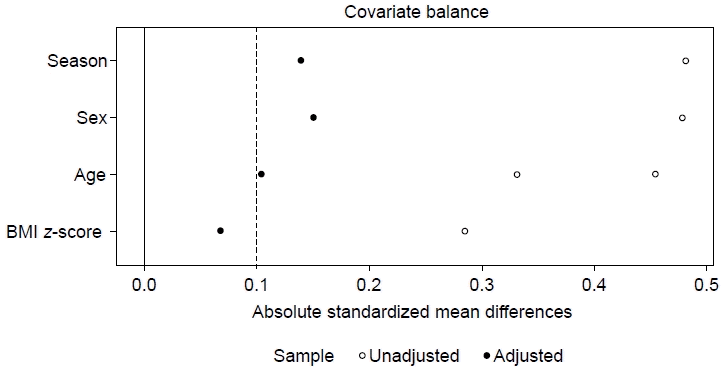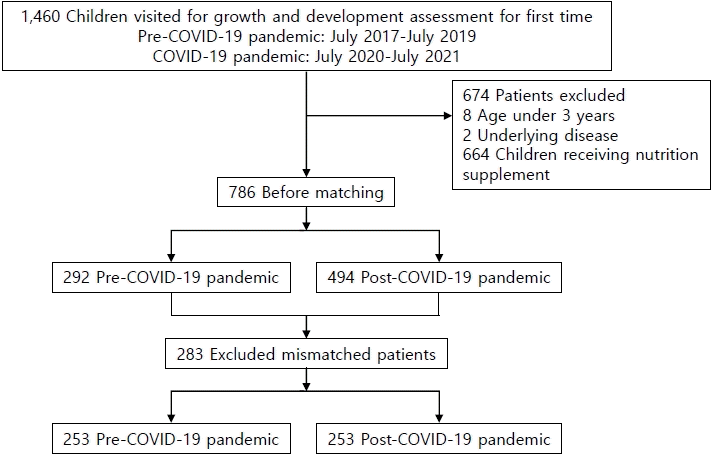1. Shin YH, Shin HJ, Lee YJ. Vitamin D status and childhood health. Korean J Pediatr. 2013; 56:417–23.

2. Zurita-Cruz J, Fonseca-Tenorio J, Villasis-Keever M, LopezAlarcon M, Parra-Ortega I, Lopez-Martinez B, et al. Efficacy and safety of vitamin D supplementation in hospitalized COVID-19 pediatric patients: a randomized controlled trial. Front Pediatr. 2022; 10:943529.

3. Ismailova A, White JH. Vitamin D, infections and immunity. Rev Endocr Metab Disord. 2022; 23:265–77.

4. O’Neill CM, Kazantzidis A, Ryan MJ, Barber N, Sempos CT, Durazo-Arvizu RA, et al. Seasonal changes in vitamin D-effective UVB availability in Europe and associations with population serum 25-hydroxyvitamin D. Nutrients. 2016; 8:533.

5. Holick MF. The vitamin D deficiency pandemic: approaches for diagnosis, treatment and prevention. Rev Endocr Metab Disord. 2017; 18:153–65.

6. Dunton GF, Do B, Wang SD. Early effects of the COVID-19 pandemic on physical activity and sedentary behavior in children living in the U.S. BMC Public Health. 2020; 20:1351.

8. Neville RD, Lakes KD, Hopkins WG, Tarantino G, Draper CE, Beck R, et al. Global changes in child and adolescent physical activity during the COVID-19 pandemic: a systematic review and meta-analysis. JAMA Pediatr. 2022; 176:886–94.
9. Kang HM, Jeong DC, Suh BK, Ahn MB. The impact of the coronavirus disease-2019 pandemic on childhood obesity and vitamin D status. J Korean Med Sci. 2021; 36:e21.

10. Beyazgül G, Bağ Ö, Yurtseven İ, Coşkunol F, Başer S, Çiçek D, et al. How vitamin D levels of children changed during COVID-19 pandemic: a comparison of prepandemic and pandemic periods. J Clin Res Pediatr Endocrinol. 2022; 14:188–95.
11. Holick MF, Binkley NC, Bischoff-Ferrari HA, Gordon CM, Hanley DA, Heaney RP, et al. Evaluation, treatment, and prevention of vitamin D deficiency: an Endocrine Society Clinical Practice Guideline. J Clin Endocrinol Metab. 2011; 96:1911–30.

12. Mosca C, Colucci A, Savoia F, Cali C, Del Bene M, Ranucci G, et al. Vitamin D levels in the pre- and post-COVID-19 pandemic periods and related confinement at pediatric age. Nutrients. 2023; 15:2089.

13. Fiamenghi VI, Mello ED. Vitamin D deficiency in children and adolescents with obesity: a meta-analysis. J Pediatr (Rio J). 2021; 97:273–9.

14. Cheng S, Massaro JM, Fox CS, Larson MG, Keyes MJ, McCabe EL, et al. Adiposity, cardiometabolic risk, and vitamin D status: the Framingham Heart Study. Diabetes. 2010; 59:242–8.

15. Zakharova I, Klimov L, Kur yaninova V, Nikitina I, Malyavskaya S, Dolbnya S, et al. Vitamin D insufficiency in overweight and obese children and adolescents. Front Endocrinol (Lausanne). 2019; 10:103.

16. Wortsman J, Matsuoka LY, Chen TC, Lu Z, Holick MF. Decreased bioavailability of vitamin D in obesity. Am J Clin Nutr. 2000; 72:690–3.

17. Wierzbicka A, Oczkowicz M. Sex differences in vitamin D metabolism, serum levels and action. Br J Nutr. 2022; 128:2115–30.

18. Muscogiuri G, Barrea L, Somma CD, Laudisio D, Salzano C, Pugliese G, et al. Sex differences of vitamin D status across BMI classes: an observational prospective cohort study. Nutrients. 2019; 11:3034.

19. Boğa A. Evaluation of the vitamin D levels of children according to seasons, gender and age. Haydarpasa Numune Med J. 2021; 61:372–6.

20. Kang S, Seo MY, Kim SH, Park MJ. Changes in lifestyle and obesity during the COVID-19 pandemic in Korean adolescents: based on the Korea Youth Risk Behavior Survey 2019 and 2020. Ann Pediatr Endocrinol Metab. 2022; 27:281–8.

21. Knapp EA, Dong Y, Dunlop AL, Aschner JL, Stanford JB, Hartert T, et al. Changes in BMI during the COVID-19 pandemic. Pediatrics. 2022; 150:e2022056552.

22. Lee A, Kim SH, Nam CM, Kim YJ, Joo SH, Lee KR. Prevalence of vitamin D deficiency and insufficiency in Korean children and adolescents and associated factors. Lab Med Online. 2016; 6:70–8.

23. Won JW, Jung SK, Jung IA, Lee Y. Seasonal changes in vitamin D levels of healthy children in mid-latitude, Asian urban area. Pediatr Gastroenterol Hepatol Nutr. 2021; 24:207–17.

24. Ha J, Lee J, Choi S, Park S. COVID-19 waves and their characteristics in the Seoul metropolitan area (Jan 20, 2020- Aug 31, 2022). Public Health Wkly Rep. 2023; 16:111–36.
26. Bener A, Al-Ali M, Hoffmann GF. Vitamin D deficiency in healthy children in a sunny country: associated factors. Int J Food Sci Nutr. 2009; 60 Suppl 5:60–70.






 PDF
PDF Citation
Citation Print
Print




 XML Download
XML Download